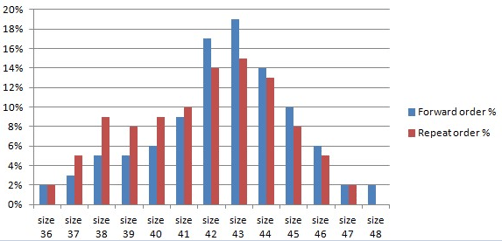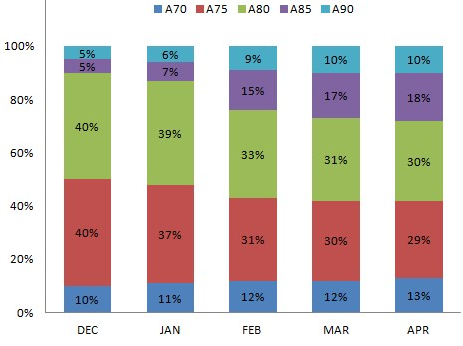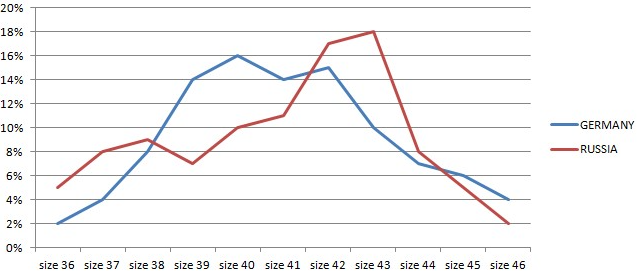Demand Planning at size level
In some industries such as fashion where many products are available in a variety of size-color-style combinations, planning at size level is very important. But since each region will have its own unique demand profile, size planning can be a very difficult topic to manage. TIA allows you to maximize your margins when an item is in season and minimize the drop at the end of the season by allowing you to plan the right size at the right time on the right market!
Size ratio re-orders
The size breakdown of the reorder potential is often determined straightforward: either the forward order size ratio is used, or the reorder quantities are allocated to the heart sizes (the middle sizes). The first ignores the fact that reorders have a different ratio; the second ignores the fact that the consumer requires more sizes.
The optimization potential lays in the awareness that there is a different reorder ratio and, even more important, this ratio can vary during the delivery period.
A strong clustering on customers and articles helps in increasing the accuracy of the reorder size breakdown.

Determining the right size of an article in the Seasonal collection
Still, most fashion companies add a certain percentage to the forward order bookings to cover repeat order demand during the delivery period. This is because the buying decision for these repeat demand has to be taken before you have any repeat order in. In some fashion area’s the share of the business done via repeat orders is growing. The simple “adding % on top” on all or selected articles of the collection, has an increased risk of over- and under buy. (See our white paper “Optimizing re-orders”, describes how to improve the estimation of which style/colors will do best during the re-order period.) Still critical however is to have the right sizes. Simply taking the size ratio of the forward orders is not accurate enough. The ratio between different sizes of an article during the repeat order period, is often not the same as the ratio of sizes of the forward order bookings. This has to do with the fact that either customers tend to buy “low risk” sizes on forward order, or that the supplier “forces” to buy standard size packs.

Actual example of the change in requested sizes during the season (bathing product)
In the example above you will recognize a standard size pack logic of the December delivery. This is the sell-in of the forward orders or first allocation to the different shops. Question arises here; “Did we miss opportunity to sell size A85 in December and January?”. This of course depends on the over-availability on sizes at load-in and if there is an opportunity to do additional buys.
Apart from the changes of sell-through sizes during the season, it’s also important to know which customer type, for example country, has the biggest re-order potential.

Actual example of difference in required sizes in different countries (Shoes)
Determining the right size of an article in the NOOS collection
The same type of issues indicated at the Seasonal collection articles also play a role at the planning of the NOOS articles. The planned future demand of a SKU should be based on future requested sizes instead of solely the deliveries until now. In June the market might want different sizes then in March because a different type of consumer might buy in different periods of the year. Also order type (sales, clearance, etc) should be taken into account. One should be careful when just looking at sell-out data when determining the best size split. Sometimes the retailer is forced to buy fixed size packages. In those situations, it happens that a sale on a size 46 is missed because the retailer cannot re-order this individual size separately to cover gaps in the size range in the store. Another important factor is the availability of a size. When not in stock the sold quantity will be zero, but demand could still be there.
With TIA it’s easy to manage all these variables thanks to the SIZE SPLIT module. Size Split allows you to set forecasts and prepare PO proposals on:
- Per style/color
- Separate size split of order and reorder
- Rolling analysis of demand per SKU
- Optimal size split per article group
- Different size splits for different channel
Feel free to ask further details to our consultants!

